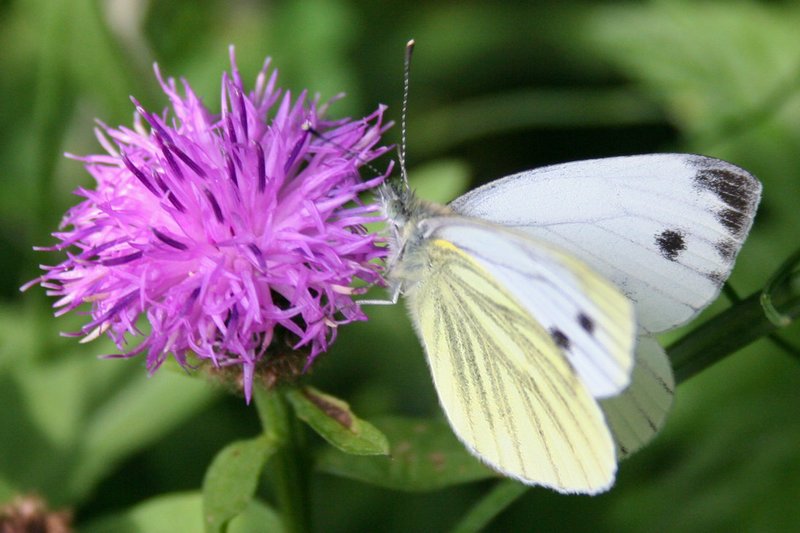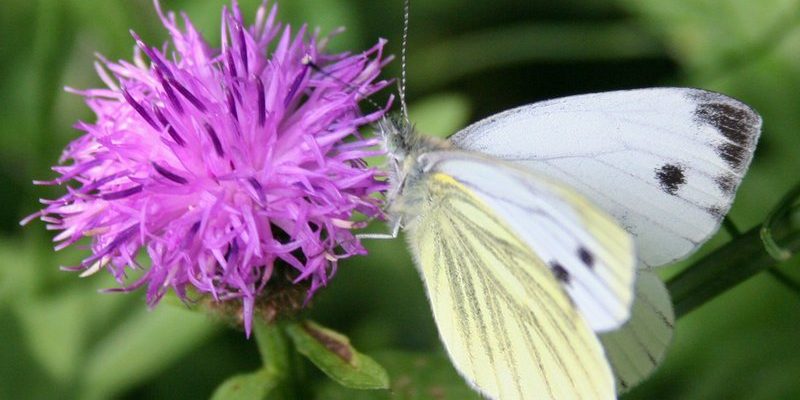
The Cabbage White Butterfly, with its delicate wings and charming flutter, is a familiar sight in gardens and fields across North America and Europe. Have you ever spotted a charming white butterfly floating past your backyard? Chances are, it was a Cabbage White. These butterflies are not just pretty; they have interesting habits and a significant role in our ecosystems. Their lifecycle, from caterpillar to adult, is a fascinating process that showcases the beauty of nature.
What makes the Cabbage White Butterfly particularly intriguing is its adaptability. You’ll often see them in urban gardens, farmland, and wildflower meadows, making them quite the survivors in various environments. In this article, we’ll delve deeper into their characteristics, habits, and the importance of their presence in our world. By the end, you’ll be equipped with lots of fun facts about this delightful little creature!
General Characteristics
The Cabbage White Butterfly is easily recognized by its pale, almost white wings, which can have touches of black spots. These butterflies can measure about 1.5 to 2.5 inches across, making them relatively small compared to some other butterfly species. The males are usually more pristine in appearance, while the females often have darker markings. This slight difference serves a purpose in the mating ritual—males need to attract females with their brighter, cleaner features.
Interestingly, Cabbage Whites undergo a complete metamorphosis, which means they transform in four distinct stages: egg, larva (caterpillar), pupa (chrysalis), and adult butterfly. Each stage comes with its own unique challenges and adaptations. For instance, the caterpillars are notorious for munching on cabbage and other leafy greens, causing quite a stir among gardeners. But this doesn’t just impact our gardens—it’s a critical part of their growth and development.
These butterflies also have a rapid breeding cycle. Depending on environmental conditions, a Cabbage White can lay about 200 to 300 eggs in its lifetime. That’s a lot of caterpillars! This prolific nature aids in their survival, allowing them to thrive in diverse settings, from city landscapes to rural fields.
Habitat and Distribution
The Cabbage White Butterfly is a well-traveled species, found in a variety of habitats across North America, Europe, and parts of Asia. They thrive in gardens, parks, agricultural fields, and even roadside areas where their favorite plants grow. You might be surprised to learn that they have an affinity for brassicas—plants like cabbage, kale, broccoli, and cauliflower. This preference for leafy greens explains their frequent appearance in vegetable gardens, where they can sometimes become nuisances to gardeners.
During warmer months, you’ll likely see them fluttering about, as they are most active in spring and summer. In colder climates, they often go into a form of hibernation as chrysalises, waiting for warmer weather to emerge as adults. This seasonal cycle reflects their ability to adapt to changing environments—something we can all learn from!
As these butterflies migrate, they can travel significant distances. Some studies indicate they can fly up to 20 miles a day in search of food and suitable habitats. This wandering nature contributes to their widespread presence, showcasing their resilience and adaptability in different ecosystems.
Life Cycle of the Cabbage White Butterfly
The life cycle of the Cabbage White Butterfly is a remarkable journey, full of transformation. It begins with the female laying tiny eggs, usually on the underside of host plants, to protect them from predators. These eggs hatch into caterpillars, or larvae, which are the most recognizable stage of their development. Cabbage White caterpillars are often green with faint striping, allowing them to blend in with their leafy food sources. It’s almost like nature’s perfect camouflage!
These caterpillars are hungry little beings, munching on leaves and growing rapidly—sometimes doubling in size in just a week! This is a crucial time, as they need to gather enough energy for the next stage of their life. After several molts, during which they shed their skin, they enter the pupal stage. Here, they form a protective casing around themselves, called a chrysalis, where all the magic happens.
Within the chrysalis, the caterpillar’s body undergoes a complete transformation, eventually emerging as a beautiful butterfly. This stage can last anywhere from a few days to several weeks, depending on environmental conditions. When they finally emerge, these butterflies are ready to take flight, adding beauty to our gardens and parks.
Diet and Feeding Habits
Cabbage White Butterflies have a diet that heavily influences their growth and survival. As caterpillars, they primarily feed on plants from the Brassicaceae family, which includes cabbages, mustards, and kale. Their voracious appetite can turn an idyllic garden into a patch of shredded greens in no time. Gardeners often find their young plants heavily nibbled on by these hungry critters, leading to a love-hate relationship.
Once they transition to adults, their diet shifts to nectar, which they extract from a variety of flowering plants. Common favorites include dandelions, clover, and various wildflowers. This nectar not only fuels their flight but also plays a vital role in pollination, helping other plants thrive. Thus, while they may cause some frustration for gardeners, Cabbage Whites contribute significantly to the ecosystem.
What’s fascinating is how the diet can affect their survival rates. Caterpillars that feed on healthy, diverse plants tend to develop into robust butterflies, whereas those with limited options can struggle. This interplay between diet and development emphasizes the delicate balance within ecosystems and highlights the importance of maintaining healthy habitats for all wildlife.
Predators and Threats
No creature is without its challenges, and the Cabbage White Butterfly is no exception. Throughout their life cycle, they face various predators that threaten their survival. Birds are perhaps their biggest nemesis, often swooping down to feast on adult butterflies. Additionally, their caterpillars are at risk from a range of insects, including parasitic wasps and spiders, which can decimate caterpillar populations.
Interestingly, these butterflies have developed some defense mechanisms over time. For instance, the pale coloration of their wings can help them blend into their surroundings, making it harder for predators to spot them. When threatened, the caterpillars may also drop to the ground, using their coloration to avoid detection. It’s a clever little escape act that showcases how they’ve evolved to respond to threats in their environment.
Unfortunately, human activities pose additional threats. Habitat loss due to urbanization and agricultural expansion can limit their breeding grounds and food sources. Pesticides used in farming can also have devastating effects on their populations. By recognizing these threats, we can take better care of our environments, ensuring these beautiful butterflies continue to grace our gardens for years to come.
Importance in Ecosystem
The presence of the Cabbage White Butterfly in our gardens and ecosystems is more than just a pretty sight; it plays a significant role in maintaining balance within those ecosystems. As pollinators, adult butterflies help fertilize flowers, encouraging plant growth and contributing to biodiversity. This is a vital function that supports the health of our gardens and wild spaces.
Moreover, their caterpillars serve as a food source for many predators, supporting various species in the food chain. While they might be seen as pests by gardeners, they contribute to the larger web of life that sustains many forms of wildlife. This interconnectedness is a reminder of how every species, no matter how small, has its own unique role in our ecosystem.
By fostering an environment that supports the Cabbage White Butterfly, we’re also promoting healthier gardens and ecosystems. Planting native flowers, avoiding harsh chemicals, and providing natural habitats can help sustain their populations and, in turn, support a diverse range of other wildlife.
Fun Facts About the Cabbage White Butterfly
- These butterflies are known for their rapid flight and can sometimes appear erratic as they dart from flower to flower.
- The Cabbage White Butterfly is actually a common name for two different species: the Pieris rapae (the more common one) and Pieris brassicae.
- They can produce multiple generations each season, which is why you might see them flying around from spring all the way through fall.
- The caterpillars can cause significant damage to crops, affecting farmers and gardeners alike.
- Cabbage White Butterflies can see ultraviolet light, which helps them locate flowers that are rich in nectar.
FAQ
What do Cabbage White Butterflies look like?
Cabbage White Butterflies are typically small, with white or yellowish wings. Males are usually pure white with a few black tips, while females can have more distinct black spots. Their wingspan ranges from about 1.5 to 2.5 inches, making them relatively small yet noticeable against their green surroundings.
Where can I find Cabbage White Butterflies?
You can commonly find Cabbage White Butterflies in gardens, fields, and meadows, especially where brassica plants are growing. They have a strong preference for areas with flowering plants, as they feed on nectar, making parks and agricultural fields prime locations for spotting them.
Are Cabbage White Butterflies harmful to gardens?
While Cabbage White Butterflies themselves aren’t harmful, their caterpillars can wreak havoc on crops, especially cabbage and other leafy greens. They can munch through entire plants, making them a concern for gardeners and farmers who want to protect their produce.
Do Cabbage White Butterflies migrate?
Yes, Cabbage White Butterflies can migrate in response to environmental conditions. While most tend to stay local, some populations will move to find suitable climates or food sources, especially during seasonal changes.
How long do Cabbage White Butterflies live?
The lifespan of a Cabbage White Butterfly can vary, but adults typically live for about 2 to 4 weeks, depending on environmental conditions and predation risks. Factors such as availability of food and habitat can also influence their lifespan.
What plants attract Cabbage White Butterflies?
Cabbage White Butterflies are attracted to plants in the Brassicaceae family, like cabbage, kale, and broccoli. You can also entice them with a variety of flowering plants, including clover and dandelions, which provide them with nectar.
How can I support Cabbage White Butterflies in my garden?
To support Cabbage White Butterflies, consider planting a mix of host plants like cabbage and flowering plants for nectar. Avoid using pesticides that can harm butterflies and their caterpillars. Creating a more diverse and native plant habitat can also help them thrive.

